List of psychoactive plants

A list of plants that are used as hallucinogens. Some of them have been used entheogenic for millennia. The plants are listed according to the substances they contain.
Contents
- 1 Cannabis
- 2 Tryptamines
- 3 Phenethylamines
- 4 Beta-carbolines
- 4.1 Apocynaceae
- 4.2 Bignoniaceae
- 4.3 Calycanthaceae
- 4.4 Chenopodiaceae
- 4.5 Combretaceae
- 4.6 Cyperaceae
- 4.7 Elaeagnaceae
- 4.8 Gramineae
- 4.9 Lauraceae
- 4.10 Leguminosae
- 4.11 Loganiaceae
- 4.12 Malpighiaceae
- 4.13 Myristicaceae
- 4.14 Ochnaceae
- 4.15 Palmae
- 4.16 Papaveraceae
- 4.17 Passifloraceae
- 4.18 Polygonaceae
- 4.19 Rubiaceae
- 4.20 Rutaceae
- 4.21 Sapotaceae
- 4.22 Simaroubaceae
- 4.23 Solanaceae
- 4.24 Symplocaceae
- 4.25 Tiliaceae
- 4.26 Zygophyllaceae
- 5 Plants containing other psychoactive substances
- 6 See also
- 7 References
- 8 Bibliography
- 9 External links
Cannabis[edit]
Cannabis (Marijuana) is a popular psychoactive plant that is often used medically and recreationally. Cannabis is also unique in that it contains a psychoactive substance, THC, which contains no nitrogen and is not an indole, tryptamine, phenethylamine, anticholinergic (deliriant), or a dissociative drug. Cannabis plants tend to vary, with different strains producing dynamic balances of psychoactive cannabinoids (THC, CBD, etc.) that cause different strains to produce markedly different effects, popular strains often being hybrids of both Cannabis sativa and Cannabis indica. Some universities and research firms currently study the medicinal effects of cannabis. Many jurisdictions have laws regulating or prohibiting the sale and use of medical and recreational cannabis.
Tryptamines[edit]

Many of the psychedelic plants contain dimethyltryptamine (DMT), which is either snorted (Virola, Yopo snuffs), smoked, or drunk with MAOIs (Ayahuasca). It cannot simply be eaten as it is not orally active without an MAOI and it needs to be extremely concentrated to be smokable.
Acanthaceae[edit]
Species, Alkaloid content, where given, refers to dried material
- Fittonia albivenis, a common ornamental plant from South America. It is useful in the treatment of headaches, etc.
- Justicia pectoralis, DMT in leaves
Aceraceae[edit]
- Acer saccharinum (Silver Maple Tree) was found to contain the indole alkaloid gramine (not active and extremely toxic) 0.05% in the leaves, so it is possible that other members of this plant family contain active compounds.[1]
Aizoaceae[edit]
- Delosperma acuminatum, DMT, 5-MEO-DMT[2]
- Delosperma cooperi, DMT, 5-MEO-DMT[2]

- Delosperma ecklonis, DMT[2]
- Delosperma esterhuyseniae, DMT[2]
- Delosperma hallii, 5-MEO-DMT[2]
- Delosperma harazianum, DMT, 5-MEO-DMT[2]
- Delosperma harazianum
Shibam, DMT[2]
- Delosperma harazianum
- Delosperma hirtum, DMT[2]
- Delosperma hallii
aff. litorale
- Delosperma hallii
- Delosperma lydenbergense, DMT, 5-MEO-DMT[2]
- Delosperma nubigenum, 5-MEO-DMT[2]

- Delosperma pageanum, DMT, 5-MEO-DMT[2]
- Delosperma pergamentaceum, Traces of DMT[2]
- Delosperma tradescantioides, DMT[2]
Apocynaceae[edit]
Fabaceae (Leguminosae)[edit]
- Acacia acuminata, Up to 1.5% alkaloids, mainly consisting of dimethyltryptamine in bark & leaf[4] Also, Harman, Tryptamine, NMT, other alkaloids in leaf.[5]
 Acacia alpina, Active principles in leaf[6][unreliable source?]
Acacia alpina, Active principles in leaf[6][unreliable source?] Acacia angustissima, β-methyl-phenethylamine,[7] NMT and DMT in leaf (1.1-10.2 ppm)[8]
Acacia angustissima, β-methyl-phenethylamine,[7] NMT and DMT in leaf (1.1-10.2 ppm)[8] Acacia aroma, Tryptamine alkaloids.[9] Significant amount of tryptamine in the seeds.[10]
Acacia aroma, Tryptamine alkaloids.[9] Significant amount of tryptamine in the seeds.[10] Acacia auriculiformis, 5-MeO-DMT in stem bark[11]
Acacia auriculiformis, 5-MeO-DMT in stem bark[11] Acacia baileyana, 0.02% tryptamine and β-carbolines, in the leaf, Tetrahydroharman[12]
Acacia baileyana, 0.02% tryptamine and β-carbolines, in the leaf, Tetrahydroharman[12]- Acacia beauverdiana, Psychoactive[13] Ash used in Pituri.[14]
 Acacia berlandieri, DMT, amphetamines, mescaline, nicotine[15]
Acacia berlandieri, DMT, amphetamines, mescaline, nicotine[15] Acacia catechu, DMT[2] and other tryptamines in leaf, bark
Acacia catechu, DMT[2] and other tryptamines in leaf, bark Acacia caven, Psychoactive[16]
Acacia caven, Psychoactive[16]- Acacia chundra, DMT and other tryptamines in leaf, bark
- Acacia colei, DMT[17]
- Acacia complanata, 0.3% alkaloids in leaf and stem, almost all N-methyl-tetrahydroharman, with traces of tetrahydroharman, some of tryptamine[18][19][20]
 Acacia confusa, DMT & NMT in leaf, stem & bark 0.04% NMT and 0.02% DMT in stem.[6] Also N,N-dimethyltryptamine N-oxide[21]
Acacia confusa, DMT & NMT in leaf, stem & bark 0.04% NMT and 0.02% DMT in stem.[6] Also N,N-dimethyltryptamine N-oxide[21] Acacia cornigera, Psychoactive,[16] Tryptamines[22] DMT according to C. Rastch.
Acacia cornigera, Psychoactive,[16] Tryptamines[22] DMT according to C. Rastch. Acacia cultriformis, Tryptamine, in the leaf, stem[6] and seeds.[10] Phenethylamine in leaf and seeds[10]
Acacia cultriformis, Tryptamine, in the leaf, stem[6] and seeds.[10] Phenethylamine in leaf and seeds[10]- Acacia cuthbertsonii, Psychoactive[13]
 Acacia decurrens, Psychoactive,[16] but less than 0.02% alkaloids[12]
Acacia decurrens, Psychoactive,[16] but less than 0.02% alkaloids[12]- Acacia delibrata, Psychoactive[13]
- Acacia falcata, Psychoactive,[13] but less than 0.02% alkaloids[12] Psychoactive 0.2-0.3% alkaloids[23]
 Acacia farnesiana, Traces of 5-MeO-DMT[24] in fruit. β-methyl-phenethylamine, flower.[25] Ether extracts about 2-6% of the dried leaf mass.[26] Alkaloids are present in the bark[27] and leaves.[28] Amphetamines and mescaline also found in tree.[22]
Acacia farnesiana, Traces of 5-MeO-DMT[24] in fruit. β-methyl-phenethylamine, flower.[25] Ether extracts about 2-6% of the dried leaf mass.[26] Alkaloids are present in the bark[27] and leaves.[28] Amphetamines and mescaline also found in tree.[22]- Acacia flavescens, Strongly Psychoactive, Bark.
- Acacia floribunda, Tryptamine, phenethylamine,[29] in flowers[10] other tryptamines,[30] DMT,tryptamine,NMT 0.3-0.4% phyllodes.[31]
- Acacia georginae, Psychoactive,[16] plus deadly toxins
 Acacia horrida, Psychoactive[16]
Acacia horrida, Psychoactive[16] Acacia implexa, Psychoactive[32]
Acacia implexa, Psychoactive[32]- Acacia jurema, DMT, NMT
 Acacia karroo, Psychoactive
Acacia karroo, Psychoactive- Acacia laeta, DMT, in the leaf[6]
 Acacia longifolia, 0.2% tryptamine in bark, leaves, some in flowers, phenylethylamine in flowers,[29] 0.2% DMT in plant.[33] Histamine alkaloids.[12]
Acacia longifolia, 0.2% tryptamine in bark, leaves, some in flowers, phenylethylamine in flowers,[29] 0.2% DMT in plant.[33] Histamine alkaloids.[12]- Acacia sophorae, Tryptamine in leaves, bark[10]
- Acacia macradenia, Tryptamine[10]
 Acacia maidenii, 0.6% NMT and DMT in about a 2:3 ratio in the stem bark, both present in leaves[6]
Acacia maidenii, 0.6% NMT and DMT in about a 2:3 ratio in the stem bark, both present in leaves[6] Acacia mangium, Psychoactive[16]
Acacia mangium, Psychoactive[16] Acacia melanoxylon, DMT, in the bark and leaf,[34] but less than 0.02% total alkaloids[12]
Acacia melanoxylon, DMT, in the bark and leaf,[34] but less than 0.02% total alkaloids[12] Acacia mellifera, DMT, in the leaf[6]
Acacia mellifera, DMT, in the leaf[6] Acacia nilotica, DMT, in the leaf[6]
Acacia nilotica, DMT, in the leaf[6]- Acacia nilotica subsp. adstringens, Psychoactive, DMT in the leaf
- Acacia neurophylla DMT in bark, Harman in leaf.[35]
- Acacia obtusifolia, Tryptamine, DMT, NMT, other tryptamines,[32] 0.4-0.5% in dried bark,0.15-0.2% in leaf, 0.07% in branch tips.[36]
- Acacia oerfota, Less than 0.1% DMT in leaf,[37] NMT
- Acacia penninervis, Psychoactive[13]
 Acacia phlebophylla, 0.3% DMT in leaf, NMT[6]
Acacia phlebophylla, 0.3% DMT in leaf, NMT[6] Acacia podalyriaefolia, Tryptamine in the leaf,[6] 0.5% to 2% DMT in fresh bark, phenethylamine, trace amounts.[29] Although this species is claimed to contain 0.5% to 2% DMT in fresh bark the reference for this is invalid as there is no reference to Acacia Podalyriffolia anywhere in the reference article. Additionally, well known and proven extraction techniques for DMT have failed to produce any DMT or alkaloids from fresh bark or the leaves on multiple sample taken at various seasons. Should DMT actually exist in this species of Acacia then it exists in extremely small amounts and have failed to produce any alkaloids with Acid/Base extraction techniques using HCl/Na(OH)2. On the same note, more academic research is definitely required into the DMT content of this and other Australian Acacia species with proper chemical analysis of sample.[citation needed]
Acacia podalyriaefolia, Tryptamine in the leaf,[6] 0.5% to 2% DMT in fresh bark, phenethylamine, trace amounts.[29] Although this species is claimed to contain 0.5% to 2% DMT in fresh bark the reference for this is invalid as there is no reference to Acacia Podalyriffolia anywhere in the reference article. Additionally, well known and proven extraction techniques for DMT have failed to produce any DMT or alkaloids from fresh bark or the leaves on multiple sample taken at various seasons. Should DMT actually exist in this species of Acacia then it exists in extremely small amounts and have failed to produce any alkaloids with Acid/Base extraction techniques using HCl/Na(OH)2. On the same note, more academic research is definitely required into the DMT content of this and other Australian Acacia species with proper chemical analysis of sample.[citation needed] Acacia polyacantha, DMT in leaf[6] and other tryptamines in leaf, bark
Acacia polyacantha, DMT in leaf[6] and other tryptamines in leaf, bark- Acacia polyacantha ssp. campylacantha, Less than 0.2% DMT in leaf, NMT; DMT and other tryptamines in leaf, bark[38]
 Acacia rigidula, DMT, NMT, tryptamine, traces of amphetamines, mescaline, nicotine and others[39]
Acacia rigidula, DMT, NMT, tryptamine, traces of amphetamines, mescaline, nicotine and others[39]- Acacia sassa, Psychoactive[16]
 Acacia schaffneri, β-methyl-phenethylamine, Phenethylamine[40] Amphetamines and mescaline also found.[22]
Acacia schaffneri, β-methyl-phenethylamine, Phenethylamine[40] Amphetamines and mescaline also found.[22] Acacia senegal, Less than 0.1% DMT in leaf,[6] NMT, other tryptamines. DMT in plant,[25] DMT in bark.[10]
Acacia senegal, Less than 0.1% DMT in leaf,[6] NMT, other tryptamines. DMT in plant,[25] DMT in bark.[10]- Acacia seyal, DMT, in the leaf.[6] Ether extracts about 1-7% of the dried leaf mass.[26]
 Acacia sieberiana, DMT, in the leaf[6]
Acacia sieberiana, DMT, in the leaf[6] Acacia simplex, DMT and NMT, in the leaf, stem and trunk bark, 0.81% DMT in bark, MMT[6][41]
Acacia simplex, DMT and NMT, in the leaf, stem and trunk bark, 0.81% DMT in bark, MMT[6][41] Acacia tortilis, DMT, NMT, and other tryptamines[32]
Acacia tortilis, DMT, NMT, and other tryptamines[32] Acacia vestita, Tryptamine, in the leaf and stem,[6] but less than 0.02% total alkaloids[12]
Acacia vestita, Tryptamine, in the leaf and stem,[6] but less than 0.02% total alkaloids[12]- Acacia victoriae, Tryptamines, 5-MeO-alkyltryptamine[10]
- List of Acacia Species Having Little or No Alkaloids in the Material Sampled:[12]
(0% C 0.02%, Concentration of Alkaloids) - Albizia inundata leaves contain DMT.[16]
 Anadenanthera colubrina, Bufotenin, Beans,[42][43] Bufotenin oxide, Beans,[42] N,N-Dimethyltryptamine, Beans,[42][43] pods,[42]
Anadenanthera colubrina, Bufotenin, Beans,[42][43] Bufotenin oxide, Beans,[42] N,N-Dimethyltryptamine, Beans,[42][43] pods,[42]- Anadenanthera colubrina var. cebil - Bufotenin and Dimethyltryptamine have been isolated from the seeds and seed pods, 5-MeO-DMT from the bark of the stems.[44] The seeds were found to contain 12.4% bufotenine, 0.06% 5-MeO-DMT and 0.06% DMT.[45]
 Anadenanthera peregrina,
Anadenanthera peregrina,
1,2,3,4-Tetrahydro-6-methoxy-2,9-dimethyl-beta-carboline, Plant,[43] 1,2,3,4-Tetrahydro-6-methoxy-2-methyl-beta-carboline, Plant,[43] 5-Methoxy-N,N-dimethyltryptamine, Bark,[43] 5-Methoxy-N-methyltryptamine, Bark,[43] Bufotenin, plant,[43] beans,[42] Bufotenin N-oxide, Fruit,[43] beans,[42] N,N-Dimethyltryptamine-oxide, Fruit[43][46]
- Anadenanthera peregrina var. peregrina, Bufotenine is in the seeds.[47]
 Desmanthus illinoensis, 0% - 0.34% DMT in root bark, highly variable.[48] Also NMT, N-hydroxy-N-methyltryptamine, 2-hydroxy-N-methyltryptamine, and gramine (toxic).[49]
Desmanthus illinoensis, 0% - 0.34% DMT in root bark, highly variable.[48] Also NMT, N-hydroxy-N-methyltryptamine, 2-hydroxy-N-methyltryptamine, and gramine (toxic).[49] Desmanthus leptolobus, 0.14% DMT in root bark, more reliable than D. illinoensis[48]
Desmanthus leptolobus, 0.14% DMT in root bark, more reliable than D. illinoensis[48]- Desmodium caudatum[50] (syn. Ohwia caudata ), Roots: 0.087% DMT,
- Desmodium intortum, Bufotentine, DMT[51]
 Codariocalyx motorius(syn. Desmodium gyrans), DMT, 5-MEO-DMT, leaves, roots
Codariocalyx motorius(syn. Desmodium gyrans), DMT, 5-MEO-DMT, leaves, roots- Desmodium racemosum, 5-MEO-DMT
 Desmodium triflorum, 0.0004% DMT-N-oxide, roots,[52] less in stems[52] and trace in leaves.[52]
Desmodium triflorum, 0.0004% DMT-N-oxide, roots,[52] less in stems[52] and trace in leaves.[52]- Leonurus sibiricus, Alkaloids
 Lespedeza capitata,
Lespedeza capitata, Lespedeza bicolor, DMT, 5-MEO-DMT in leaves and roots[53]
Lespedeza bicolor, DMT, 5-MEO-DMT in leaves and roots[53]- Lespedeza bicolor var. japonica, DMT, 5-MEO-DMT in leaves and root bark
- Mimosa ophthalmocentra, Dried root: DMT 1.6%, NMT 0.0012% and hordenine 0.0065%[54]
 Mimosa scabrella, Tryptamine, NMT, DMT and N-methyltetrahydrocarboline in bark[55]
Mimosa scabrella, Tryptamine, NMT, DMT and N-methyltetrahydrocarboline in bark[55]- Mimosa somnians, Trytamines and MMT
 Mimosa tenuiflora (syn. "Mimosa hostilis"), 0.31-0.57% DMT (dry root bark).[56]
Mimosa tenuiflora (syn. "Mimosa hostilis"), 0.31-0.57% DMT (dry root bark).[56] Mimosa verrucosa, DMT[57] in root bark
Mimosa verrucosa, DMT[57] in root bark Mucuna pruriens, "The leaves, seeds, stems and roots contain L-Dopa, Serotonin, 5-HTP, and Nicotine, as well as N,N-DMT, Bufotenine, and 5-MeO-DMT."[58]
Mucuna pruriens, "The leaves, seeds, stems and roots contain L-Dopa, Serotonin, 5-HTP, and Nicotine, as well as N,N-DMT, Bufotenine, and 5-MeO-DMT."[58]- Petalostylis casseoides, 0.4-0.5% tryptamine, DMT, etc. in leaves and stems[53]
- Petalostylis labicheoides var. casseoides, DMT in leaves and stems
- Phyllodium pulchellum(syn. Desmodium pulchellum), 0.2% 5-MeO-DMT, small quantities of DMT[53] DMT (dominates in seedlings and young plants), 5-MEO-DMT (dominates in mature plant), whole plant, roots, stems, leaves, flowers
- Erythrina flabelliformis, other Erythrina species, seeds contain the alkaloids Erysodin and Erysovin[59]
Caesalpinioideae subfamily[edit]
- Petalostylis cassioides: 0.4-0.5% tryptamine, DMT, etc. in leaves and stems[60]
- Petalostylis labicheoides, Tryptamines in leaves and stems, MAO's up to 0.5%[61]
- Lauraceae
Malpighiaceae[edit]
- Diplopterys cabrerana: DMT 0.17-1.74%, average of 0.47% DMT[62]
Myristicaceae[edit]
- Horsfieldia superba: 5-MeO-DMT[53] and beta-carbolines[60]
- Iryanthera macrophylla: 5-MeO-DMT in bark[53]
- Iryanthera ulei: 5-MeO-DMT in bark
- Osteophloem platyspermum: DMT, 5-MeO-DMT in bark
- Virola calophylla, Leaves 0.149% DMT, leaves 0.006% MMT 5-MeO-DMT in bark[63]
- Virola callophylloidea, DMT
- Virola carinata, DMT in leaves
- Virola cuspidata, DMT[61]
- Virola divergens, DMT in leaves
 Virola elongata(syn. Virola theiodora), DMT, 5-MEO-DMT in bark, roots, leaves and flowers
Virola elongata(syn. Virola theiodora), DMT, 5-MEO-DMT in bark, roots, leaves and flowers- Virola melinonii, DMT in bark
- Virola multinervia, DMT, 5-MEO-DMT in bark and roots
- Virola pavonis, DMT in leaves
- Virola peruviana, 5-MEO-DMT, traces of DMT and 5-MeO-tryptamine in bark
- Virola rufula, Alkaloids in bark and root, 95% of which is MeO-DMT[64] 0.190% 5-MeO-DMT in bark, 0.135% 5-MeO-DMT in root, 0.092% DMT in leaves.
- Virola sebifera, The bark contains 0.065% to 0.25% alkaloids, most of which are DMT and 5-MeO-DMT.[65]
- Virola surinamensis, DMT[61] in bark
- Virola venosa, DMT, 5-MEO-DMT in roots, leaves DMT
Ochnaceae[edit]
- Testulea gabonensis: 0.2% 5-MeO-DMT, small quantities of DMT,[53] DMT in bark and root bark, NMT
Ochnaceae[edit]
Poaceae (Gramineae)[edit]
Some Graminae (grass) species contain gramine, which can cause brain damage, other organ damage, central nervous system damage and death in sheep.[66]
 Arundo donax, 0.0057% DMT in dried rhizome, no stem, 0.026% bufotenine, 0.0023% 5-MeO-MMT[67]
Arundo donax, 0.0057% DMT in dried rhizome, no stem, 0.026% bufotenine, 0.0023% 5-MeO-MMT[67] Phalaris aquatica, 0.0007-0.18% Total alkaloids,[68] 0.100% DMT,[69] 0.022% 5-MeO-DMT,[69] 0.005% 5-OH-DMT[69]
Phalaris aquatica, 0.0007-0.18% Total alkaloids,[68] 0.100% DMT,[69] 0.022% 5-MeO-DMT,[69] 0.005% 5-OH-DMT[69] Phalaris arundinacea, 0.0004-0.121% Total alkaloids[68]
Phalaris arundinacea, 0.0004-0.121% Total alkaloids[68]- Phalaris brachystachys, Aerial parts up to 3% total alkaloids, DMT present[citation needed]
 Phragmites australis, DMT in roots. None of the above alkaloids are said to have been found in Phalaris californica, Phalaris canariensis, Phalaris minor and hybrids of P. arundinacea together with P. aquatica.[68]
Phragmites australis, DMT in roots. None of the above alkaloids are said to have been found in Phalaris californica, Phalaris canariensis, Phalaris minor and hybrids of P. arundinacea together with P. aquatica.[68]
Polygonaceae[edit]
- Erigonum sp.: DMT
Punicaceae[edit]
- Punica granatum "DMT in root cortex;"[61] The dried stem and root bark of the tree contain about 0.4-0.9% alkaloids.[70]
Rubiaceae[edit]
- Psychotria carthagenensis, 0.2% average DMT in dried leaves
- Psychotria expansa, DMT[61]
- Psychotria forsteriana, DMT[61]
- Psychotria insularum, DMT[61]
 Psychotria poeppigiana,[71] DMT[61]
Psychotria poeppigiana,[71] DMT[61]- Psychotria rostrata, DMT[61]
- Psychotria rufipilis, DMT[61]
 Psychotria viridis, DMT 0.1-0.61% dried mass.[72]
Psychotria viridis, DMT 0.1-0.61% dried mass.[72]
Rutaceae[73][74][edit]
 Dictyoloma incanescens, 5-MeO-DMT in leaves,[64] 0.04% 5-MeO-DMT in bark[53]
Dictyoloma incanescens, 5-MeO-DMT in leaves,[64] 0.04% 5-MeO-DMT in bark[53]- Dutaillyea drupacea, > 0.4% 5-MeO-DMT in leaves[32]
- Dutaillyea oreophila, 5-MeO-DMT in leaves
 Tetradium ruticarpum(syn. Evodia rutaecarpa), 5-MeO-DMT in leaves, fruit and roots
Tetradium ruticarpum(syn. Evodia rutaecarpa), 5-MeO-DMT in leaves, fruit and roots Limonia acidissima, 5-MeO-DMT in stems
Limonia acidissima, 5-MeO-DMT in stems- Euodia leptococca (formerly Melicope), 0.2% total alkaloids, 0.07% 5-MeO-DMT; 5-MeO-DMT in leaves and stems, also "5-MeO-DMT-Oxide and a beta-carboline"[60]
- Pilocarpus organensis, 5-MeO-DMT in leaves
- Vepris ampody, Up to 0.2% DMT in leaves and branches[53]
- Zanthoxylum arborescens, DMT in leaves
- Zanthoxylum procerum, DMT in leaves
Urticaceae[edit]
- Urtica pilulifera: Bufotenin[61]
Phenethylamines[edit]
Species, Alkaloid Content (Fresh) - Alkaloid Content (Dried)
- Echinopsis lageniformis
 (syn. Trichocereus bridgesii), Mescaline > 0.025%,[75] also 3,4-dimethoxyphenylethylamine < 1%, 3-methoxytyramine < 1%, tyramine < 1% - Mescaline 2%[76]
(syn. Trichocereus bridgesii), Mescaline > 0.025%,[75] also 3,4-dimethoxyphenylethylamine < 1%, 3-methoxytyramine < 1%, tyramine < 1% - Mescaline 2%[76] - Echinopsis scopulicola
 (syn. Trichocereus scopulicola), Mescaline[77]
(syn. Trichocereus scopulicola), Mescaline[77] - Echinopsis pachanoi
 (syn. Trichocereus pachanoi), Mescaline 0.006-0.12%, 0.05% Average[78] - Mescaline 0.01%-2.375%[78]
(syn. Trichocereus pachanoi), Mescaline 0.006-0.12%, 0.05% Average[78] - Mescaline 0.01%-2.375%[78] - Echinopsis spachiana
 (syn. Trichocereus spachianus), Mescaline[79] - Mescaline[79]
(syn. Trichocereus spachianus), Mescaline[79] - Mescaline[79] - Lophophora williamsii
 (Peyote), 0.4% Mescaline[77] - 3-6% Mescaline[79]
(Peyote), 0.4% Mescaline[77] - 3-6% Mescaline[79] - Opuntia acanthocarpa
 Mescaline[79]
Mescaline[79] - Opuntia basilaris
 Mescaline 0.01%, plus 4-hydroxy-3-5-dimethoxyphenethylamine[79]
Mescaline 0.01%, plus 4-hydroxy-3-5-dimethoxyphenethylamine[79] - Austrocylindropuntia cylindrica (syn. Opuntia cylindrica),[80] Mescaline[79]
- Cylindropuntia echinocarpa
 (syn. Opuntia echinocarpa), Mescaline 0.01%, 3-4-dimethoxyphenethylamine 0.01%, 4-hydroxy-3-5-dimethoxyphenethylamine 0.01%[79]
(syn. Opuntia echinocarpa), Mescaline 0.01%, 3-4-dimethoxyphenethylamine 0.01%, 4-hydroxy-3-5-dimethoxyphenethylamine 0.01%[79] - Cylindropuntia spinosior (syn. Opuntia spinosior),[81] Mescaline 0.00004%, 3-methoxytyramine 0.001%, tyramine 0.002%, 3-4-dimethoxyphenethylamine.[79]
- Echinopsis macrogona
 (syn. Trichocereus macrogonus), > 0.01-0.05% Mescaline[82]
(syn. Trichocereus macrogonus), > 0.01-0.05% Mescaline[82] - Echinopsis peruviana
 (syn. Trichocereus peruvianus), Mescaline 0.0005%-0.12%[78] - Mescaline
(syn. Trichocereus peruvianus), Mescaline 0.0005%-0.12%[78] - Mescaline - Echinopsis tacaquirensis subsp. taquimbalensis (syn. Trichocereus taquimbalensis),[83] > 0.005-0.025% Mescaline[82]
- Echinopsis terscheckii
 (syn. Trichocereus terscheckii, Trichocereus werdemannianus)[84] > 0.005-0.025% Mescaline[82] - Mescaline 0.01%-2.375%[78]
(syn. Trichocereus terscheckii, Trichocereus werdemannianus)[84] > 0.005-0.025% Mescaline[82] - Mescaline 0.01%-2.375%[78] - Echinopsis valida, 0.025% Mescaline[77]
- Pelecyphora aselliformis, Mescaline[77]
Beta-carbolines[edit]
Beta-carbolines are "reversible" MAO-A inhibitors. They are found in some plants used to make Ayahuasca. In high doses the harmala alkaloids are somewhat hallucinogenic on their own.
Apocynaceae[edit]
- Amsonia tabernaemontana, Harmine
- Aspidosperma exalatum, Beta-carbolines[85]
- Aspidosperma polyneuron, Beta-carbolines[85]
- Apocynum cannabinum, Harmalol
- Ochrosia nakaiana, Harman
- Pleicarpa mutica, Beta-carbolines[85]
Bignoniaceae[edit]
- Newbouldia laevis, Harman
Calycanthaceae[edit]
Chenopodiaceae[edit]
- Hammada leptoclada, Tetrahydroharman, etc.
- Kochia scoparia, Harmine, etc.
Combretaceae[edit]
- Guiera senegalensis, Harman, etc.
Cyperaceae[edit]
- Carex brevicollis, Harmine, etc.
- Carex parva, Beta-carbolines[85]
Elaeagnaceae[edit]
- Elaeagnus angustifolia, Harman, etc.

- Elaeagnus commutata, Beta-carbolines[85]
- Elaeagnus hortensis, Tetrahydroharman, etc.
- Elaeagnus orientalis, Tetrahydroharman
- Elaeagnus spinosa, Tetrahydroharman
- Hippophae rhamnoides, Harman, etc.
- Shepherdia argentea, Tetrahydroharmol

- Shepherdia canadensis, Tetrahydroharmol
Gramineae[edit]
- Arundo donax, Tetrahydroharman

- Festuca arundinacea, Harman, etc.

- Lolium perenne, (Perennial Ryegrass), Harman, etc.

- Phalaris aquatica, Beta-carbolines[85]
- Phalaris arundinacea, Beta-carbolines[85]
Lauraceae[edit]
- Nectandra megapotamica, Beta-carbolines[85]
Leguminosae[edit]
- Acacia baileyana, Tetrahydroharman
- Acacia complanata, Tetrahydroharman, etc.
- Burkea africana, Harman, etc.
- Desmodium gangeticum, Beta-carbolines[85]
- Desmodium gyrans, Beta-carbolines[85]
- Desmodium pulchellum, Harman, etc.
- Mucuna pruriens, 6-Methoxy-Harman
- Petalostylis labicheoides, Tetrahydroharman; MAO's up to 0.5%[61]
- Prosopis nigra, Harman, etc.
- Shepherdia pulchellum, Beta-carbolines[85]
Loganiaceae[edit]
- Strychnos melinoniana, Beta-carbolines[85]
- Strychnos usambarensis, Harman[85]
Malpighiaceae[edit]
- Banisteriopsis argentia, 5-methoxytetrahydroharman, (−)-N(6)-methoxytetrahydroharman, dimethyltryptamine-N(6)-oxide[7]
- Banisteriopsis caapi, Harmine 0.31-0.84%,[86] tetrahydroharmine, telepathine, dihydroshihunine,[87] 5-MeO-DMT in bark[88]

- Banisteriopsis inebrians, Beta-carbolines[85]
- Banisteriopsis lutea, Harmine, telepathine[7]
- Banisteriopsis metallicolor, Harmine, telepathine[7]
- Banisteriopsis muricata, Harmine up to 6%, harmaline up to 4%, plus DMT[89]
- Diplopterys cabrerana, Beta-carbolines[85]
- Cabi pratensis, Beta-carbolines[85]
- Callaeum antifebrile(syn. Cabi paraensis), Harmine
- Tetrapterys methystica(syn. Tetrapteris methystica), Harmine[90]
Myristicaceae[edit]
- Gymnacranthera paniculata, Beta-carbolines[85]
- Horsfieldia superba Beta-carbolines[60]
- Virola cuspidata, 6-Methoxy-Harman
- Virola rufula, Beta-carbolines[85]
- Virola theiodora, Beta-carbolines[85]
Ochnaceae[edit]
- Testulea gabonensis, Beta-carbolines[85]
Palmae[edit]
- Plectocomiopsis geminiflora, Beta-carbolines[85]
Papaveraceae[edit]
- Meconopsis horridula, Beta-carbolines[85]
- Meconopsis napaulensis, Beta-carbolines[85]

- Meconopsis paniculata, Beta-carbolines[85]
- Meconopsis robusta, Beta-carbolines[85]
- Meconopsis rudis, Beta-carbolines[85]
- Papaver rhoeas, Beta-carbolines[85]

Passifloraceae[edit]
- Passiflora actinia, Harman
- Passiflora alata, Harman
- Passiflora alba, Harman
- Passiflora bryonoides, Harman
- Passiflora caerulea, Harman

- Passiflora capsularis, Harman
- Passiflora decaisneana, Harman
- Passiflora edulis, Harman, 0-7001 ppm[25] in fruit

- Passiflora eichleriana, Harman
- Passiflora foetida, Harman

- Passiflora incarnata (with bee), Harmine, Harmaline, Harman, etc. 0.03%.[91] Alkaloids in rind of fruit 0.25%[91]

- Passiflora quadrangularis, Harman

- Passiflora ruberosa, Harman
- Passiflora subpeltata, Harman

- Passiflora warmingii, Harman
Polygonaceae[edit]
- Calligonum minimum, Beta-carbolines[85]
- Leptactinia densiflora, Leptaflorine, etc.
- Ophiorrhiza japonica, Harman
- Pauridiantha callicarpoides, Harman
- Pauridiantha dewevrei, Harman
- Pauridiantha lyalli, Harman
- Pauridiantha viridiflora, Harman
- Simira klugei, Harman
- Simira rubra, Harman
Rubiaceae[edit]
- Borreria verticillata, Beta-carbolines[85]
- Leptactinia densiflora, Beta-carbolines[85]
- Nauclea diderrichii, Beta-carbolines[85]
- Ophiorrhiza japonica, Beta-carbolines[85]
- Pauridiantha callicarpoides, Beta-carbolines[85]
- Pauridiantha dewevrei, Beta-carbolines[85]
- Pauridiantha yalli, Beta-carbolines[85]
- Pauridiantha viridiflora, Beta-carbolines[85]
- Pavetta lanceolata, Beta-carbolines[85]
- Psychotria carthagenensis, Beta-carbolines[85]
- Psychotria viridis, Beta-carbolines[85]
- Simira klugei, Beta-carbolines[85]
- Simira rubra, Beta-carbolines[85]
- Uncaria attenuata, Beta-carbolines[85]
- Uncaria canescens, Beta-carbolines[85]
- Uncaria orientalis, Beta-carbolines[85]
Rutaceae[edit]
- Tetradium (syn. Evodia) species: Some contain carbolines
- Euodia leptococca Beta-carboline[60]
- Araliopsis tabouensis, Beta-carbolines[85]
- Flindersia laevicarpa, Beta-carbolines[85]
- Xanthoxylum rhetsa, Beta-carbolines[85]
Sapotaceae[edit]
- Chrysophyllum lacourtianum, Norharman etc.
- Scutellaria
- Scutellaria nana
Simaroubaceae[edit]
- Ailanthus malabarica, Beta-carbolines.[85] See also Nag Champa.
- Perriera madagascariensis, Beta-carbolines[85]
- Picrasma ailanthoides, Beta-carbolines[85]
- Picrasma crenata, Beta-carbolines[85]
- Picrasma excelsa, Beta-carbolines[85]
- Picrasma javanica, Beta-carbolines[85]
Solanaceae[edit]
- Vestia foetida, (Syn V. lycioides) Beta-carbolines[85]

Symplocaceae[edit]
- Symplocos racemosa, Harman
Tiliaceae[edit]
- Grewia mollis, Beta-carbolines[85]
Zygophyllaceae[edit]
- Fagonia cretica, Harman

- Nitraria schoberi, Beta-carbolines[85]
- Peganum harmala, (Syrian Rue), The seeds contain about 2-6% alkaloids, most of which is harmaline.[92] Peganum harmala is also an abortifacient.

- Peganum nigellastrum, Harmine[93]
- Tribulus terrestris, Harman

- Zygophyllum fabago, Harman, harmine
Plants containing other psychoactive substances[edit]
|
|
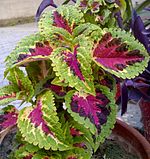
|
Unknown |
 |

|
Salvinorin A, 0.89-3.87 mg/g, also Salvinorin B and Salvinorin C[94] |
 |

|
Khat[95] |
 |
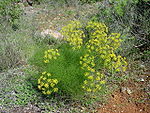
|
Unknown |
 |
Unknown | |
 |

|
Pukateine |
 |
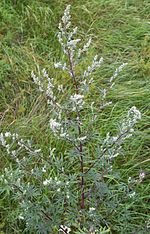
|
Thujone |
 |

|
Damianin |
 |

|
[96] |
 |

|
Bulbocapnine, Nantenine, Tetrahydropalmatine |
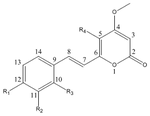 |

|
Kavalactones |
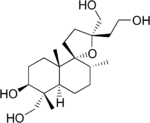 |

|
Lagochilin is thought to be responsible for the sedative, hypotensive and hemostatic effects of this plant. |
 |

|
Anethole, Chavicol, Coumarin, Estragole, Isorhamnetin, Methyleugenol, Quercitin |
 |
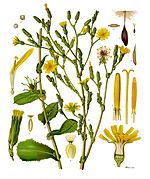
|
Lactucarium |
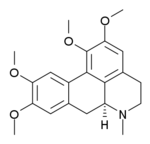 |
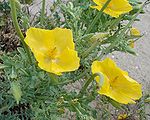
|
Glaucine |
 |

|
Galbulimima belgraveana is rich in alkaloids and twenty-eight alkaloids have been isolated. Himbacine, himbeline, himandravine, himgravine, himbosine, himandridine, himandrine, G.B. 1, G. B. 2, G. B. 3, G. B. 4, G. B. 5, G. B. 6, G. B. 7, G. B. 8, G. B. 9, G. B. 10, G. B. 11, G. B. 12, himgaline, himbadine, G. B. 13, himgrine, G. B. 14, G. B. 15, G. B. 16, G. B. 17 and G. B. 18. |
 |

|
Zornia latifolia, is mentioned in Food of the Gods as "an hallucinogenic substitute for cannabis". It's nicknamed Maconha brava because locals use it as a cannabis substitute. |
 |

|
Used by Chinese residents of Mexico during the early 20th century as a legal substitute for opium and currently smoked as a marijuana substitute. |
 |

Argyreia nervosa (Hawaiian Baby Woodrose) |
Seeds contain high amounts of LSA (also known as d-lysergic acid amide, d-lysergamide, ergine, and LA-111), often 50-150X the amounts found in Ipomoea violacea. |
 |

|
Ibogaine in root bark[97] |
 |
Ibogaine in root leaves[97] | |
 |
Ibogaine and similar alkaloids[97] | |
 |
Tabernaemontana sp. |
Ibogaine[97] |
 |

|
Ibogaine[98] |
 |

|
Recent studies have shown Nymphaea caerulea to have psychedelic properties, and may have been used as a sacrament in ancient Egypt and certain ancient South American cultures. Dosages of 5 to 10 grams of the flowers induces slight stimulation, a shift in thought processes, enhanced visual perception, and mild closed-eye visuals. Nymphaea caerulea is related to, and possesses similar activity as Nelumbo nucifera, the Sacred Lotus. Both Nymphaea caerulea and Nelumbo nucifera contain the alkaloids nuciferine and apomorphine, which have been recently isolated by independent labs.[citation needed]
These psychoactive effects make Nymphaea caerulea a likely candidate (among several) for the lotus plant eaten by the mythical Lotophagi in Homer's Odyssey. Used in aromatherapy, Nymphaea caerulea is purported to have a "divine" essence, bringing euphoria, heightened awareness and tranquility.[citation needed] Other sources cite anti-spasmodic and sedative, purifying and calming properties. |
 |

|
Both leaves and flowers (where most concentrated) contain Leonurine. (Effects reminiscent of marijuana) |
 |

|
Both leaves and flowers (where most concentrated) contain Leonurine. (Effects reminiscent of marijuana) |
 |

|
Produces vivid dreams after smoking. It is also employed by the Chontal people as a medicinal herb against gastrointestinal disorders, and is used as an appetizer, cathartic anti-dysentery remedy, and as a fever-reducing agent. Its psychedelic properties do not become apparent until the user is asleep. |
 |

|
Produces vivid dreams after smoking. |
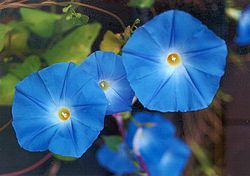 Ipomoea tricolor & Ipomoea violacea Ipomoea tricolor & Ipomoea violacea |
|
|
|
Seeds contain D-lysergic acid amide, lysergol, and turbicoryn; lysergic acid alkaloids up to 0.03%[100] |
|
|
|
Apocynaceae family:
- Catharanthus roseus is (perhaps unpleasantly) "hallucinogenic."[101]
- Vinca minor
Aquifoliaceae family:
- Ilex guayusa, which is used as an additive to some versions of Ayahuasca. According to the Ecuadorian indigenous, it is also slightly hallucinogenic on its own, when drunk in high enough quantities.
Euphorbiaceae family:
Loganaceae family:
- Desfontainia spinosa, causes visions[102]
Lythraceae family:
- Heimia myrtifolia, auditory[103]
- Heimia salicifolia, auditory[103]
See also[edit]
- Aztec entheogenic complex
- Entheogenic drugs and the archaeological record
- God in a Pill?
- Hallucinogenic fish
- Hallucinogenic plants in Chinese herbals
- List of entheogenic/hallucinogenic species
- List of plants used for smoking
- List of poisonous plants
- Louisiana State Act 159
- Psilocybin mushrooms
- Psychoactive cacti
References[edit]
- ^ IJ PACHTER, DE ZACHARIAS, O RIBEIRO - The Journal of Organic Chemistry, 1959 -
- ^ a b c d e f g h i j k l m n "entheogen.com". Retrieved 14 January 2015. Cite error: Invalid
<ref>tag; name "sacred" defined multiple times with different content (see the help page). - ^ "Profiles of Psychedelic Drugs". paranoia.lycaeum.org. Retrieved 2008-04-19.
- ^ "Lycaeum > Leda > Acacia acuminata". leda.lycaeum.org. Retrieved 2008-02-23.
- ^ "The Acacia Analysis Thread - Plant Analysis and Substance Testing - Welcome to the DMT-Nexus". Dmt-nexus.me. Retrieved 2013-10-14.
- ^ a b c d e f g h i j k l m n o "Plants & Seeds > A > Acacia spp. - Shaman Australis Botanicals". Retrieved 14 January 2015.
- ^ a b c d Glasby, John Stephen (1991). Dictionary of Plants Containing Secondary Metabolites. CRC Press. p. 2. ISBN 0-85066-423-3.
- ^ Nutritive value assessment of the tropical shrub legume Acacia angustissima: anti-nutritional compounds and in vitro digestibility. Personal Authors: McSweeney, C. S., Krause, D. O., Palmer, B., Gough, J., Conlan, L. L., Hegarty, M. P.Author Affiliation: CSIRO Livestock Industries, Long Pocket Laboratories, 120 Meiers Road, Indooroopilly, Qld 4068, Australia. Document Title: Animal Feed Science and Technology, 2005 (Vol. 121) (No. 1/2) 175-190
- ^ "Maya Ethnobotanicals - Ayahuasca, Rainforest Plants, Folklore, Incenses, Art & Visions". Retrieved 14 January 2015.
- ^ a b c d e f g h Black Panther. "Akacje". Retrieved 14 January 2015.
- ^ "Lycaeum > Leda > Acacia auriculiformis". Retrieved 14 January 2015.
- ^ a b c d e f g Caesalpinioideae und Mimosoideae. Retrieved 14 January 2015.
- ^ a b c d e Australian Bush Food and Native Medicine Forum members. "Australian Bushfood (Bushtucker) and Native Medicine Forum ::". Retrieved 14 January 2015.
- ^ Duboisia hopwoodii - Pituri Bush - Solanaceae - Central America
- ^ "Ask Dr. Shulgin Online September 26, 2001". Retrieved 14 January 2015.
- ^ a b c d e f g h Index of Rätsch, Christian. Enzyklopädie der psychoaktiven Pflanzen, Botanik, Ethnopharmakologie und Anwendungen, 7. Auflage. AT Verlag, 2004, 941 Seiten. ISBN 3-85502-570-3 at [1] (German)
- ^ "Dr Karl's Q&A forum". Retrieved 14 January 2015.
- ^ "comp phyto". Retrieved 14 January 2015.
- ^ "acacias and entheogens". Retrieved 14 January 2015.
- ^ "Lycaeum > Leda > Acacia complanata". Retrieved 14 January 2015.
- ^ NMR spectral assignments of a new chlorotryptamine alkaloid and its analogues from Acacia confusa Malcolm S. Buchanan, Anthony R. Carroll, David Pass, Ronald J. Quinn Magnetic Resonance in Chemistry Volume 45, Issue 4 , Pages359 - 361. John Wiley & Sons, Ltd.
- ^ a b c Naturheilpraxis Fachforum (German)
- ^ "Trying to improve Acacia information - Collaborative Research Project - Welcome to the DMT-Nexus". Dmt-nexus.me. Retrieved 2013-10-14.
- ^ "Lycaeum > Leda > Acacia cultriformis". Retrieved 14 January 2015.
- ^ a b c "Plant Choices - Phytochemeco Databases". Retrieved 14 January 2015.
- ^ a b Vivid Interactive and Design. "Rural Industries Research and Development Corporation - Page Not Found" (PDF). Retrieved 14 January 2015.
- ^ www.bpi.da.gov.ph
- ^ "Acacia farnesiana". Retrieved 14 January 2015.
- ^ a b c Hegnauer, Robert (1994). Chemotaxonomie der Pflanzen. Springer. p. 500. ISBN 3-7643-2979-3.
- ^ "Lycaeum > Leda > Acacia floribunda". leda.lycaeum.org. Retrieved 2008-02-23.
- ^ Voogelbreinder, S. "Garden Of Eden" 2009
- ^ a b c d "Lista över hallucinogena växter, svampar och djur". Retrieved 14 January 2015. Cite error: Invalid
<ref>tag; name "magis" defined multiple times with different content (see the help page). - ^ "Lycaeum > Leda > Acacia longifolia". leda.lycaeum.org. Retrieved 2008-02-23.
- ^ extentech.sheetster.com
- ^ S. Voogelbreinder "Garden Of Eden" 2009
- ^ "obtusifolia phyto". Retrieved 14 January 2015.
- ^ Plants Containing DMT (German)
- ^ "Acacia campylacantha - Hortipedia". www.hortipedia.org. Retrieved 2008-02-23.
- ^ "Acacia rigidula - Magiska Molekylers Wiki". wiki.magiskamolekyler.org. Retrieved 2008-02-23.
- ^ Chemistry of Acacias from South Texas
- ^ Arbeitsstelle für praktische Biologie (APB)
- ^ a b c d e f UNO
- ^ a b c d e f g h i Dr. Duke's Phytochemical and Ethnobotanical Databases Cite error: Invalid
<ref>tag; name "drduke" defined multiple times with different content (see the help page). - ^ herbotecnia. "Cultivo de Curupay, Cebil colorado (Anadenanthera colubrina) y usos, herbotecnia". Retrieved 14 January 2015.
- ^ "Bufo alvarius - Jonathan Ott on Bufotenine". www.erowid.org. Retrieved 2008-02-23.
- ^ Psychedelics Encyclopedia. Retrieved 14 January 2015.
- ^ Ott J. "Pharmañopo-psychonautics: human intranasal, sublingual, intrarectal... - PubMed - NCBI". Retrieved 14 January 2015.
- ^ a b "Erowid Online Books : "Ayahuasca: alkaloids, plants, and analogs" by Keeper of the Trout". Retrieved 14 January 2015.
- ^ Google Book Search. books.google.com. 1996-07-30. ISBN 978-3-7643-5165-6. Retrieved 2008-05-08.
- ^ "Desmodium caudatum information from NPGS/GRIN". www.ars-grin.gov. Retrieved 2008-05-02.
- ^ "crcsalinity.com" (PDF). Retrieved 14 January 2015.
- ^ a b c Trout's Notes on Desmodium
- ^ a b c d e f g h i "Erowid Psychoactive Vaults : Tryptamine FAQ". Retrieved 14 January 2015.
- ^ "Isolation and Identification of Putative Hallucinogenic Constituents from the Roots of Mimosa ophthalmocentra - Pharmaceutical Biology". www.informaworld.com. Retrieved 2008-04-20.
- ^ Google Book Search. books.google.com. 1996-07-30. ISBN 978-3-7643-5165-6. Retrieved 2008-05-07.
- ^ "Ask Erowid : ID 75 : What is the DMT content of Mimosa hostilis rootbark?". Retrieved 14 January 2015.
- ^ "UNODC Bulletin on Narcotics 1969".
- ^ "Erowid Mucuna pruriens Vault". Retrieved 14 January 2015.
- ^ "Kalifornischer Korallenstrauch (Erythrina decora) im GIFTPFLANZEN.COMpendium - giftpflanzen.com". www.giftpflanzen.com. Retrieved 2008-04-18.
- ^ a b c d e "tryptamines: fungi". Retrieved 14 January 2015.
- ^ a b c d e f g h i j k l m Plants Containing DMT Cite error: Invalid
<ref>tag; name "dmt-nexus" defined multiple times with different content (see the help page). - ^ "Psychonaut". Retrieved 14 January 2015.
- ^ "Species Information". sun.ars-grin.gov. Retrieved 2008-04-11.
- ^ a b "5-MEO-DMT". Retrieved 14 January 2015.
- ^ Committee for veterinary medicinal products virola sebifera summary report
- ^ Toxicants of Plant Origin - Google Book Search. books.google.com. 1989. ISBN 978-0-8493-6990-2. Retrieved 2008-04-20.
- ^ "Erowid Arundo donax Vaults : Trout's Notes on Tryptamine Content of Arundo donax". Retrieved 14 January 2015.
- ^ a b c "DMT, Life and the Universe". Retrieved 14 January 2015.
- ^ a b c "Erowid Phalaris Vault : FAQ 2.01". Retrieved 14 January 2015.
- ^ Pomegranate (Herbdata New Zealand)
- ^ "Psychotria poeppigiana - Uragoga tomentosa". Discover Life. Retrieved 2013-10-14.
- ^ Amazing Nature
- ^ Servillo, L; Giovane, A; Balestrieri, ML; Cautela, D; Castaldo, D (Sep 2012). "N-methylated tryptamine derivatives in citrus genus plants: identification of N,N,N-trimethyltryptamine in bergamot". J Agric Food Chem. 60: 9512–8. doi:10.1021/jf302767e. PMID 22957740.
- ^ Servillo, L; Giovane, A; Balestrieri, ML; Casale, R; Cautela, D; Castaldo, D (May 2013). "Citrus genus plants contain N-methylated tryptamine derivatives and their 5-hydroxylated forms". J Agric Food Chem. 61: 5156–62. doi:10.1021/jf401448q. PMID 23682903.
- ^ "Partial List of Alkaloids in Trichocereus Cacti". Thenook.org. Retrieved 2013-10-14.
- ^ Trichocereus
- ^ a b c d Lycaeum Cite error: Invalid
<ref>tag; name "guide" defined multiple times with different content (see the help page). Cite error: Invalid<ref>tag; name "guide" defined multiple times with different content (see the help page). Cite error: Invalid<ref>tag; name "guide" defined multiple times with different content (see the help page). - ^ a b c d Forbidden Fruit Archives
- ^ a b c d e f g h "Descriptions of psychoactive Cacti.". Retrieved 14 January 2015. Cite error: Invalid
<ref>tag; name "mesc" defined multiple times with different content (see the help page). - ^ Austrocylindropuntia cylindrica <http://www.desert-tropicals.com>
- ^ "Cane Cholla (Cylindropuntia spinosior)". Retrieved 14 January 2015.
- ^ a b c Partial List of Alkaloids in Trichocereus Cacti
- ^ "Echinopsis tacaquirensis ssp. taquimbalensis". Retrieved 14 January 2015.
- ^ "Cardon Grande (Echinopsis terscheckii)". Retrieved 14 January 2015.
- ^ a b c d e f g h i j k l m n o p q r s t u v w x y z aa ab ac ad ae af ag ah ai aj ak al am an ao ap aq ar as at au av aw ax ay az ba bb bc bd "Cornell University Department of Animal Science". Retrieved 14 January 2015.
- ^ Callaway, JC; Brito, GS; Neves, ES (2005). "Phytochemical analyses of Banisteriopsis caapi and Psychotria viridis". Journal of Psychoactive Drugs. 37 (2): 145–150. doi:10.1080/02791072.2005.10399795. PMID 16149327.
- ^ Directory Of Plants Containing Secondary Metabolites. Retrieved 14 January 2015.
- ^ "Chemical Information". sun.ars-grin.gov. Retrieved 2008-04-11.
- ^ "Silbrige Ayahuasca-Liane (Banisteriopsis muricata) im GIFTPFLANZEN.COMpendium - giftpflanzen.com". www.giftpflanzen.com. Retrieved 2008-04-18.
- ^ Erowid - Ayahuasca: alkaloids, plants & analogs http://www.erowid.org/library/books_online/ayahuasca_apa/aya_sec2_malpighiaceoussource.shtml
- ^ a b "Passion Flower". Retrieved 14 January 2015.
- ^ www.amazing-nature.com
- ^ Ma, ZZ; Hano, Y; Nomura, T; Chen, YJ (April 2000). "Alkaloids and phenylpropanoids from Peganum nigellastrum". Phytochemistry. 53 (8): 1075–8. doi:10.1016/S0031-9422(99)00440-9. PMID 10820833. Retrieved 2008-01-12.
- ^ "Salvia divinorum Clones". Retrieved 14 January 2015.
- ^ Al Zarouni, Yousif (2015). The Effects of Khat (Catha Edulis) (First ed.). London: Yousif Al Zarouni. p. 5. ISBN 978-1-326-24867-3.
- ^ https://books.google.com/books?id=Rs5rAwAAQBAJ&pg=PT2377&lpg=PT2377&dq=Magnolia+virginiana+psychoactive&source=bl&ots=Fkgv-oyfF7&sig=RQTvcJFvs9M4AbHbkISSNdjB2ns&hl=en&sa=X&ved=0ahUKEwjq5NKP8crKAhWM7RQKHaOTBv4Q6AEIPDAD#v=onepage&q=Magnolia%20virginiana%20psychoactive&f=false
- ^ a b c d "Erowid Online Books : "TIHKAL" - #25 IBOGAINE". Retrieved 14 January 2015.
- ^ Dr. B. Bös. "Sternjasmin (Trachelospermum jasminoides) im GIFTPFLANZEN.COMpendium - giftpflanzen.com". Retrieved 14 January 2015.
- ^ "Trichterwinde (Ipomoea violacea) im GIFTPFLANZEN.COMpendium - giftpflanzen.com". www.giftpflanzen.com. Retrieved 2008-04-18.
- ^ "Ololiuqui (Rivea corymbosa) im GIFTPFLANZEN.COMpendium - giftpflanzen.com". www.giftpflanzen.com. Retrieved 2008-04-18.
- ^ "Protected Blog". Retrieved 14 January 2015.
- ^ Schultes, Richard Evans, Iconography of New World Plant Hallucinogens. p. 101
- ^ a b "Erowid Sinicuichi Vault : FAQ (heimia salicifolia Frequently Asked Questions)". Retrieved 14 January 2015.
Bibliography[edit]
- Al Zarouni, Yousif (2015). The Effects of Khat (Catha Edulis). London: Yousif Al Zarouni.
External links[edit]
- The Salvia Divinorum Blog Research And Information
- The Salvia Divinorum Mass Distribution Project
- Descriptions of psychoactive Cacti. Lycaeum Visionary Cactus Guide
- "Herbal Highs – Legal Buds Reviews" Components of street drug alternatives sold and used legally.
- Erowid Tryptamine FAQ – More Plants Containing Tryptamines
- John Stephen Glasby, Dictionary of Plants Containing Secondary Metabolites, Published by CRC Press
- Golden Guide to Hallucinogenic Plants
- Hallucinogens on the Internet: A Vast New Source of Underground Drug Information John H. Halpern, M.D. and Harrison G. Pope, Jr., M.D.
- [2] – Peter L. Katavic, Chemical Investigations of the Alkaloids From the Plants Of The Family Elaeocarpaceae, School of Science/Natural Product Discovery (NPD), Faculty of Science, Griffith University
- Alexander T. Shulgin, Psychotomimetic Drugs: Structure-Activity Relationships
- UNODC The plant kingdom and hallucinogens (part II)
- UNODC The plant kingdom and hallucinogens (part III)
- Virola – Dried Herbarium Specimens
- Virola Species Pictures – USGS
- Desmanthus illinoensis – USDA
- A General Introduction to Ayahuasca
- Psychedelic Reader (Google Books)


